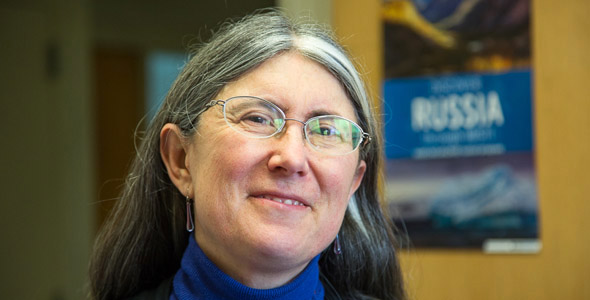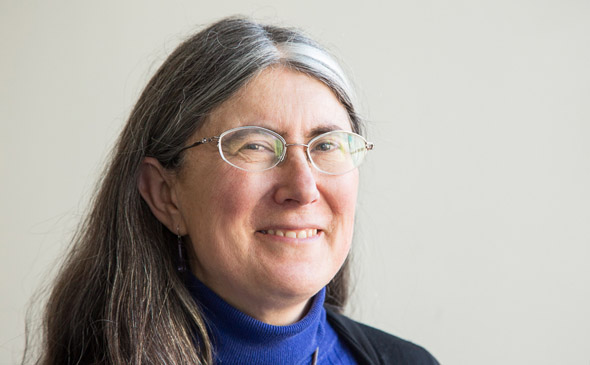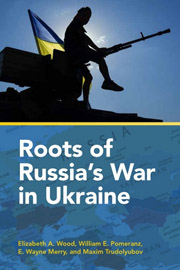The Roots of the Ukraine Crisis
Elizabeth Wood probes history for answers to Russia's posture on the world stage

“What we need is to focus on the many areas where we and the Russians can work together productively — for example, on climate, avian flu, optics, math modeling. The antidote to conflict is to build more bridges.”
— Elizabeth A. Wood, Professor of History, and Director of MISTI-Russia, a division of MISTI (the MIT International Science and Technology Initiatives)
In February 2014, Russian troops rolled into Crimea, the garden spot of Ukraine, and seized control, shocking the international community. MIT Professor Elizabeth A. Wood’s new book asks why Russia annexed this peninsula, plumbing the depths of history to explain Russia’s posture on the world stage.
“What they want is to be a great power. They are willing to break the rules if that will get them the respect and a return to great power status,” Wood said in a recent interview with SHASS Communications. A historian, Wood is the co-author of Roots of Russia’s War in Ukraine (Woodrow Wilson Center Press, 2015).
Power and Status
The 1990s collapse of the Soviet Union stripped many Russians of their life savings and stratified the society into the very rich and very poor. Today, the repercussions of this transformation are still being felt. “We have to understand the degree to which the ‘90s left Russia feeling humiliated, anarchic, and very anxious,” Wood said.
Following the Soviet collapse, the European Union (EU) coalesced, and the United States began to claim a role as the world’s lone superpower. “In the US in the 1990s, we start to say we can be the policeman to the world. From others’ perspective, that looks like world domination,” Wood said.
Ultimately, efforts to bring Ukraine into the EU brought broiling issues to a head. “For the Russians it appeared as if NATO was the proverbial schoolyard, and everyone had ganged up against them,” Wood said.
Analyzing the Russian perspective
While Ukrainian President Viktor Yanukovych had promised to sign an association agreement with the EU, on November 21, 2013, he reneged in favor of maintaining closer relations with Russia. This move spurred protests that began in Ukraine’s capital, Kyiv, and spread — underscoring a longstanding division in the country between Russophiles and those seeking closer connections with Europe.
On Nov. 30, the Ukrainian authorities started shooting the protesters, and the situation devolved. In February 2014, Yanukovych fled the country and Russia seized the Crimean peninsula — without bloodshed. On March 18, 2014, Crimea was officially incorporated into the Russian Federation.
The world was shocked by Russia’s actions, but Wood and her fellow scholars reveal the many antecedents of the events in Roots of Russia’s War in Ukraine, which was released in December. The book emerged from a panel discussion on Russia’s conduct in Ukraine that took place on March 19, 2015, at the Woodrow Wilson Center, a non-partisan institution dedicated to tackling global issues through independent research and open dialogue.
“The mission of the panel was to tell the Russian side of the story, to answer the question: Why did Russia feel compelled to get involved in Crimea?” said Wood, who participated in the Wilson Center panel. “The book is a rich tapestry of four completely different perspectives on this crisis.”

The 1990s collapse stripped many Russians of their life savings and stratified the society into the very rich and very poor. Today, the repercussions of this transformation are still being felt. “We have to understand the degree to which the ‘90s left Russia feeling very anxious,” Wood says.
Roots of the invasion
Wood, an expert on Russian President Vladimir Putin, wrote the introduction to the book as well as one of its four chapters. Her essay for the book, “A Small, Victorious War: The Symbolic Politics of Vladimir Putin,” focuses on how valuable such a military success was to Putin, whose hold on power has long depended upon projecting an image of masculine strength. “Successful saber-rattling had led to rises in Putin’s popularity ratings on three prior occasions,” Wood writes. “These spikes in popularity correlate with Putin’s aggression toward perceived internal and external enemies.”
The protesters in Ukraine directly challenged Russia’s power by evoking the history of Soviet domination while making their case for closer association with Europe. This provided Putin with the opportunity to portray himself as the protector of Russia. In her chapter, Wood points out that Putin justified Russia’s invasion after the fact as “gathering the Russian lands.”
Wood’s co-authors provide other views of the Ukrainian crisis. E. Wayne Merry, senior fellow for Europe and Eurasia at the American Foreign Policy Council in Washington, D.C., asserts that the conflict emerged from a clash of “civilization choices.” Whereas the EU operates comfortably with multiple sovereignties, Merry says Russia sees itself as a great nation with a neighborhood, and Ukraine is in its neighborhood.
William E. Pomeranz, deputy director of the Kennan Institute for Advanced Russian Studies at the Wilson Center, argues that the root of the problem is trade. If Russia allowed Ukraine to join the EU, it would open Russia’s doors to a flood of European goods, which would cripple the nation’s economy.
Maxim Trudolyubov, editor-at-large of the independent Russian daily Vedomosti, maintains that Russia faced a “grand choice”: either it could be feared as a superpower or it could be economically prosperous as a nation. While the action in Ukraine suggests it chose the former, Trudolyubov suggests that for the Russian people, the decision has yet to be made.
Taken as a whole, Roots of Russia’s War in Ukraine reveals the many ways in which individual human actors influence events — as well as the degree to which national ties and the history of a people fuel current conflicts.
Image-making and symbolic politics in Putin's Russia
Wood emphasized that understanding Putin’s pattern of behavior is critical to predicting what Russia might do next. “[Putin] has chosen to rule through image-making,” said Wood, who is now working on another book that delves even more deeply into Putin’s rule and symbolic politics. “That rule is not about a contest over ideas and policies, but rather projecting power and strength.”
In addition to her research and teaching, Wood also directs MISTI-Russia, a division of the MIT International Science and Technology Initiatives (MISTI), MIT’s flagship international education program, which is orchestrated by MIT-SHASS faculty and staff. MISTI-Russia creates ongoing opportunities for MIT students and faculty to collaborate on projects with Russian educational, scientific, and industrial organizations.
Drawing on insights from her leadership in MISTI-Russia and from her research, Wood said that, going forward, the key to better relations with Russia will be to find commonalities and areas where Russians and Americans can work together — as Russian and American scientists already do.
“What we need is to focus on the many areas where we can work together productively — for example, on climate, avian flu, optics, math modeling,” said Wood. “I think the antidote [to conflict] is to build more bridges.”
Story prepared by SHASS Communications
Editor, Designer: Emily Hiestand, Communication Director
Senior Writer: Kathryn O'Neill
Photograph: Jon Sachs
